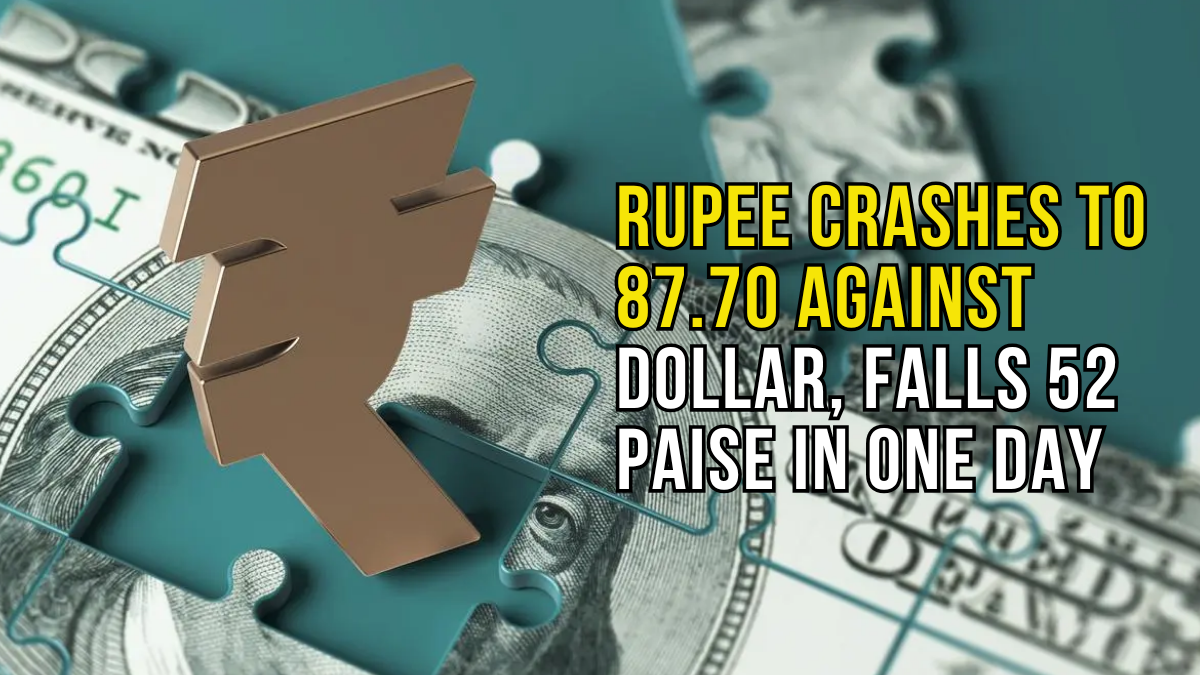On Monday, August 4, 2025, the Indian rupee continued its downward trajectory, closing at ₹87.6550 against the U.S. dollar. Despite beginning the session with a slight recovery, persistent dollar demand from oil-importing companies and ongoing foreign investor outflows led to a renewed weakening of the currency by the end of the trading day.

The rupee’s movement reflects a complex interplay of global and domestic factors — from shifts in U.S. monetary expectations to corporate dollar demand and geopolitical developments like recent tariff announcements by Donald Trump. This article breaks down all contributing elements to the rupee’s recent slump and explores what lies ahead.
Summary Table: Rupee VS Dollar
| Key Details | Information |
|---|---|
| Topic | Rupee decline against USD |
| Reason for Decline | Foreign investor outflows, dollar demand from oil firms |
| Rupee Closing Rate (Aug 4, 2025) | ₹87.6550 per USD |
| Opening Rate | ₹87.2250 |
| Recent Lowest Rate | ₹87.74 on August 1, 2025 |
| Dollar Index Status (Aug 4, 2025) | 98.92, down 0.27% |
| RBI’s Role | Intervening to stabilize rupee |
| Foreign Equity Outflows (July 2025) | $2 billion |
| Expected Influencing Factor | RBI monetary policy decision |
| Official Source | https://www.rbi.org.in |
Rupee Starts Strong, Ends Weak: A Day of Volatility
The rupee opened at ₹87.2250, stronger than Friday’s close of ₹87.5400, riding on a slightly weaker U.S. dollar. This initial strength was driven by optimism following a softer-than-expected U.S. non-farm payroll report released on Friday. The weak data stoked expectations that the Federal Reserve could implement a rate cut as early as September, which typically puts downward pressure on the dollar.
The dollar index, which measures the value of the dollar against a basket of major global currencies, was down 0.27%, standing at 98.92 as of 10:25 GMT. This temporary softness should have supported emerging market currencies like the rupee.
However, that optimism faded quickly.
Oil Firms and Importers Drive Demand for Dollars
By mid-session, demand for U.S. dollars by Indian importers — particularly state-owned oil companies — picked up sharply. These firms regularly require large amounts of dollars to pay for international crude oil purchases, and with oil prices holding steady globally, this demand was sustained throughout the day.
Oil is India’s largest import, and fluctuations in dollar requirements from refineries often dictate the rupee’s day-to-day movement. According to traders, this dollar demand “erased early gains” made by the rupee during morning trade.
Impact of Trump’s Tariff Announcement
Another factor contributing to the rupee’s weakness was former U.S. President Donald Trump’s surprise announcement of a 25% tariff on Indian exports. The announcement came just days earlier and rattled financial markets across Asia, including India.
On August 1, the rupee had dropped to ₹87.74 — its lowest level since February 2025, and just shy of its all-time low of ₹87.95. Trump’s protectionist stance is widely viewed as a threat to India’s export-dependent sectors like textiles, electronics, and pharmaceuticals.
This tariff risk adds an external layer of uncertainty, deterring investors and putting added pressure on the rupee.
RBI’s Silent Intervention
According to sources in the foreign exchange market, the Reserve Bank of India (RBI) was active throughout the week in efforts to support the currency. While the central bank doesn’t publicly disclose real-time interventions, traders reported sporadic dollar sales by the RBI in the open market to stem volatility and prevent a breach of the all-time low.
The RBI has historically adopted a strategy of intervening in the forex markets during periods of excessive volatility without pursuing a fixed exchange rate. This tactic is aimed at managing inflation, preserving forex reserves, and maintaining investor confidence.
Foreign Portfolio Outflows Continue to Hurt
Another key contributor to the rupee’s depreciation is the persistent foreign capital outflows from Indian equity markets. In July 2025 alone, foreign institutional investors (FIIs) pulled out $2 billion on a net basis, spooked by global risk-off sentiment and rising geopolitical uncertainties.
Such outflows increase demand for dollars as foreign investors convert their rupee holdings back into their home currencies, placing further downward pressure on the local currency.
Market Outlook: Stability Ahead or More Pressure?
Despite the current weakness, some analysts believe the rupee may stabilize in the coming sessions, depending on a few key factors:
1. RBI’s Monetary Policy Meeting
Later this week, the RBI’s bi-monthly monetary policy meeting is scheduled. Any shift in repo rate, inflation guidance, or forex commentary will have a significant influence on market sentiment.
“The RBI’s decision will be closely watched. Even if rates are left unchanged, forward guidance can steer rupee expectations,” said Dilip Parmar, a foreign exchange analyst at HDFC Securities.
2. US Interest Rate Expectations
Continued soft U.S. economic data may further cement expectations of a Fed rate cut, which could weaken the dollar globally and provide some relief to the rupee.
3. Crude Oil Prices
Oil prices remain a double-edged sword. Rising global prices will escalate India’s import bill and increase dollar demand, while a decline in prices will ease that pressure.
Comparison with Other Asian Currencies
While the rupee continued to struggle, other Asian currencies posted modest gains on Monday, aided by a weakening dollar:
- Malaysian Ringgit rose nearly 1%, making it the top regional performer
- Thai Baht and Indonesian Rupiah also gained slightly
- Chinese Yuan remained largely flat, with the PBOC maintaining tight control
This divergence suggests that regional fundamentals and country-specific risks are playing a large role in currency performance, with India currently facing stronger external headwinds.
FAQs: Indian Rupee and Dollar Demand Trends
1. Why is the Indian rupee falling against the U.S. dollar?
The rupee is under pressure due to strong dollar demand from oil importers, consistent foreign investor outflows, and recent geopolitical risks like U.S. tariff threats.
2. What role does the RBI play in stabilizing the rupee?
The RBI intervenes in the forex market by buying or selling dollars to reduce excess volatility. It also sets policy rates that influence currency movement.
3. How much foreign investment outflow occurred in July 2025?
Foreign institutional investors sold $2 billion worth of Indian equities on a net basis during July 2025.
4. What was the rupee’s closing rate on August 4, 2025?
The rupee closed at ₹87.6550 per U.S. dollar, compared to the previous close of ₹87.5400.
5. Is the rupee expected to stabilize soon?
Some analysts believe the rupee may stabilize depending on RBI’s upcoming policy decision, the U.S. interest rate outlook, and crude oil price trends.
Conclusion: Rupee Under Pressure, But Outlook Conditional
In summary, the Indian rupee’s continued slide is being driven by a combination of global dollar strength, corporate demand from oil importers, and foreign capital outflows. Despite these challenges, the outlook is not entirely bleak.
The RBI’s active role in the market, combined with potential external developments like a U.S. rate cut or falling oil prices, could provide the rupee with some breathing room. However, the ongoing tariff threat from the U.S. and uncertainties in global trade continue to pose risks.
Investors and policymakers alike will be watching the RBI’s monetary policy stance closely in the coming days for signs of how India plans to address both domestic inflation and external currency volatility.
Official Sources and Further Reading
- Reserve Bank of India (RBI)
- Ministry of Finance – Economic Affairs
- Bloomberg: Indian Currency News
- HDFC Securities – Forex Insights
For More Information Click HERE




